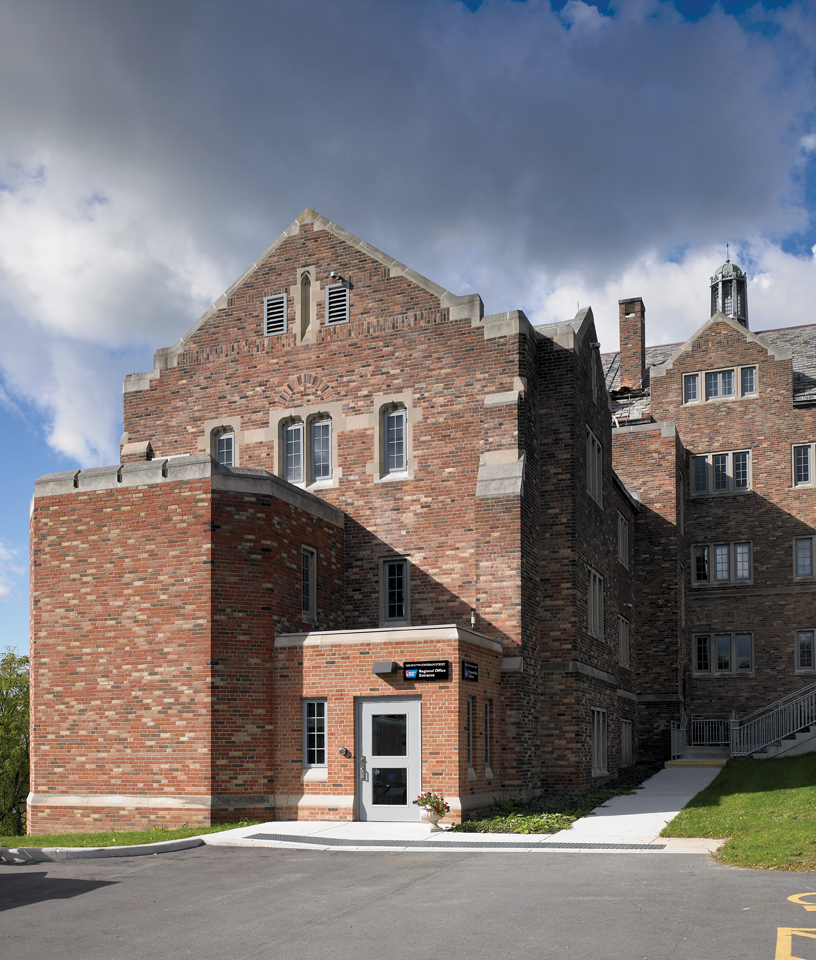The B. Thomas Golisano Hope Lodge Hospitality House, located on the edge of the Colgate Rochester Crozier Divinity School (CRCDS) campus in Rochester, N.Y., was destined to change the lives of many who have called the building home.
Constructed in the 1930s, the structure hosted CRCDS’s theological studies while serving as a seminary dormitory. Composed and rendered in the collegiate gothic style by architect James Gamble Rogers, the “Castle on the Hill” echoed similar structures found on the campuses of Yale, Columbia, and Northwestern.
Over time, the number of students requiring dormitories dwindled, and CRCDS found itself with more space than it needed.
Eventually, school officials decided to operate within a smaller footprint. However, CRCDS was still tasked with maintaining all campus buildings, including the now-vacant structure. As expenses related to the building mounted, school officials considered demolishing it.
With the future of the structure in doubt, the nearby American Cancer Society’s Rochester Hope Lodge was quickly outgrowing its facility of 25 years. It did not take long before CRCDS and American Cancer Society realized the benefits of a partnership.
Click here to view profiles of other reconstruction projects that have been recognized as part of BD+C's 28th Annual Reconstruction Awards.
As the partnership between CRCDS and American Cancer Society evolved, the CRCDS’s vacant theological studies center and seminary dormitory were selected as the home for the new Hope Lodge. Design concepts were quickly formulated, and a budget established thanks to $8 million in fundraising efforts, led by philanthropist B. Thomas Golisano.
The early stages of the reconstruction project progressed smoothly until a hazardous materials survey conducted on the facility revealed the presence of asbestos in the finishes and roofing materials. But it was also infused in the plaster covering the walls and ceilings throughout the buildings.
GIVING THE BUILDING ENVELOPE THE ONCE-OVER
In addition to the asbestos removal, the existing floor layout would have to be gutted as the narrow double-loaded corridor did not meet current egress requirements. The single-occupant rooms were cramped and much too small for the needs of Hope Lodge. Finally, the historic masonry exterior and the slate roof of the building had suffered decades of deferred maintenance and were in need of repair.
“We were, in many ways, creating a new building envelope. The restoration of the historic exterior required close coordination with the new interior perimeter,” says Jim Durfee, AIA, principal architect, Bergmann Associates.
The Building Team, consisting of local firms Bergmann Associates (architect), Torchia Structural Engineering (structural engineer), and LeChase Construction (construction manager), faced other design issues on the Hope Lodge project as well.
PRODUCT LIST
B. Thomas Golisano Hope Lodge, Hospitality House, Rochester, N.Y.Masonry Cleaner: Sure Klean
Roofing: Carlisle Epdm
Windows: Oldcastle Ogep Series 2000
Gypsum Board: USG
Window Treatments: Drapery Industries
Interior Signage & Donor Wall: Id Sign Systems
Artwork: Great American Art (Brontman’s Corporate Dimensions)
Furniture: Om Workspace (Carolina & Grand Rapids)
Lamps: Crown Electric
Interior Architectural Woodwork: Solid Surface, Zodiak
Solid Surface: Corian
Plastic Laminate: Formica
Plastic Laminate: Wilsonart
Acoustical Ceiling: Acoustical Ceiling Tile, Armstrong World Industries, Inc.
Tile Carpeting: Modular Tile Carpet, 24" X 24" Shaw Contract Group Collection, Dressed To Kill
Modular Tile Carpet: 18" X 18" Bentley Prince Street Collection, Saturnia
Modular Carpet Tile: 24"X24" Patcraft & Design Weave Collection, Construkt Series
Walk-Off Mat: 12"X12" Roppe Surface Walk-Off Mat Collection, 'Rop-Cord' Rubber (Tire Tread) Tiles
Interior Paint: Sherwin Williams, Pro-Green Interior Latex
Toilet Compartments: Hadrian
Plumbing Fixtures: American Standard
Fan Coils: Enviro-Tec Johnson Controls
Heat Recovery Units: RenewAire
Air Handlers: Mcquay
Elevators: Otis
One complicated design-related issue involved the original engineering of the two adjoining structures, Trevor and Eaton Halls. The independent structures each had their own floor levels, which did not align. “The existing footprint was particularly challenging. The fact that these were really two separate buildings separated by a quirky staircase made achieving a clear floor layout difficult,” says Durfee.
In order to get the buildings to function as one structure, a strategically located ramp allowed the second level of the structure to function contiguously while a centrally located stair with multiple flights and landings to each building provided occupant circulation.
The Building Team also faced low floor-to-ceiling heights that complicated insertion of a new HVAC system. Eventually, a four-pipe, console fan coil system was installed in order to minimize the need to extensive air distribution ductwork.
“The biggest challenge was threading new utilities through the new layout working around a very limited floor to floor height. This required careful design and utility coordination in order to maintain our aesthetic goals for the space,” says Durfee.
Handicap accessibility throughout the facility also proved problematic. The development of two exterior access points on different levels of the complex and the strategic insertion of two new elevator shafts provided a solution.
BUILDING TEAM EARNS CLIENT’S RESPECT
Hope Lodge provides free lodging and support for out-of-town patients drawn to the regional medical treatment centers in Rochester. By offering patients and caregivers a temporary home during extended periods of treatment, the Hope Lodge program frees patients from emotional and financial burdens, allowing them to concentrate on care, recovery, and quality of life.
The new 28,000-sf B. Thomas Golisano Hope Lodge Hospitality House doubled the capacity of the former Rochester Hope Lodge, while also providing 8,000 sf of office space for the American Cancer Society.
Irregular shell space resulted in unique layouts for all 30 guest rooms, each of which included a private bathroom. Common spaces and services include laundry, kitchen, dining room, living area, and a library.
On the exterior, the gothic architecture was fully restored, including the masonry, the replacement of the slate roof, and new steel sash windows that maintained the appearance of the original windows.
“I was initially concerned about the various complexities inherent in this project and with the structure of the building we were to renovate,” says Matthew Flanigan, regional vice president, American Cancer Society. “Very quickly, the Building Team assured us they were up to the task, and just as quickly began to show they were qualified. Working with this team of professionals was seamless through the many phases of planning to post-construction wrap up. Ultimately, it’s the Hope Lodge Hospitality House guests that have confirmed our true pleasure in this outcome.” BD+C
--
Click here to view profiles of other reconstruction projects that have been recognized as part of BD+C's 28th Annual Reconstruction Awards.
Related Stories
| May 21, 2012
Winchester High School receives NuRoof system
Metal Roof Consultants attended a school board meeting and presented a sloped metal retrofit roof as an alternative to tearing off the existing roof and replacing it with another flat roof.
| May 17, 2012
EMerge Alliance forms new Campus Microgrid Technical Standards Committee
Intel leading the charge to connect multiple DC microgrids throughout commercial buildings; others invited to join effort.
| May 16, 2012
AIA issues guide to IGCC
Getting the IgCC adopted in all 50 states and in jurisdictions across the country is the primary mission of the ICC, which published the code in March.
| May 16, 2012
Architecture Billings Index reverts to negative territory
Decline is possibly a brief pause from unusually strong winter activity.
| May 16, 2012
AEG releases 3D video of L.A.'s Farmers Field
The Los Angeles Convention Center footage depicts the new convention center hall spaces, including a new lobby above Pico Boulevard, pre-function space, and what will be the largest multi-purpose ballroom in Los Angeles.
| May 16, 2012
Balfour Beatty Construction taps Kiger as VP of operations
Kiger will manage current relationships and pursue other strategic clients, including select healthcare clients and strategic project pursuits in the Central Tennessee region.
| May 15, 2012
One World Trade Center goes to new height of sustainability
One of the biggest challenges in developing this concrete mixture was meeting the Port Authority of New York/New Jersey’s strict requirement for the replacement of cement.
| May 15, 2012
Suffolk selected for Rosenwald Elementary modernization project
The 314-student station elementary school will undergo extensive modernization.
| May 15, 2012
Don’t be insulated from green building
Examining the roles of insulation and manufacturing in sustainability’s growth.
| May 15, 2012
National Tradesmen Day set for Sept. 21
IRWIN Tools invites the nation to honor "The Real Working Hands that Build America and Keep it Running Strong".
















